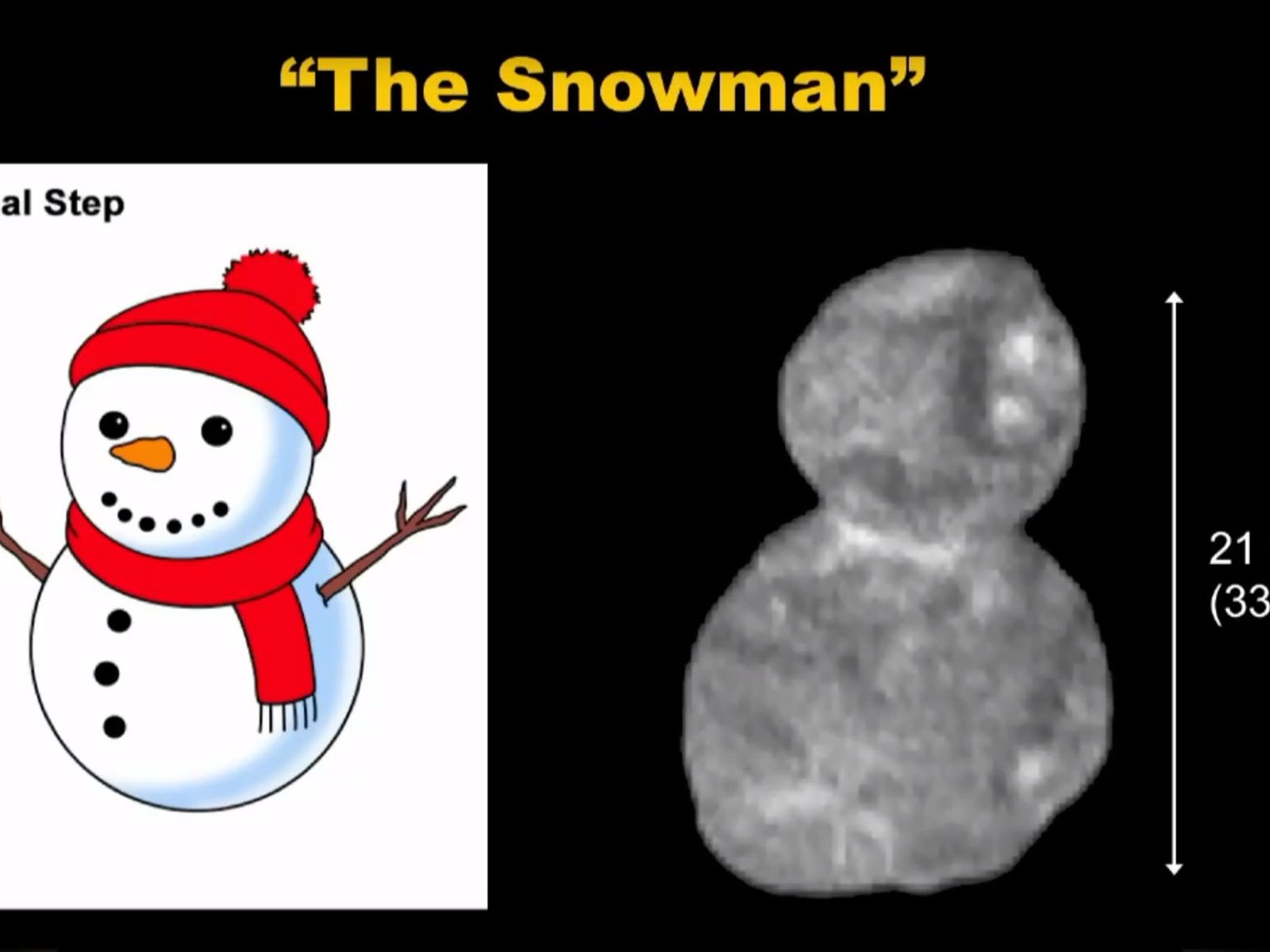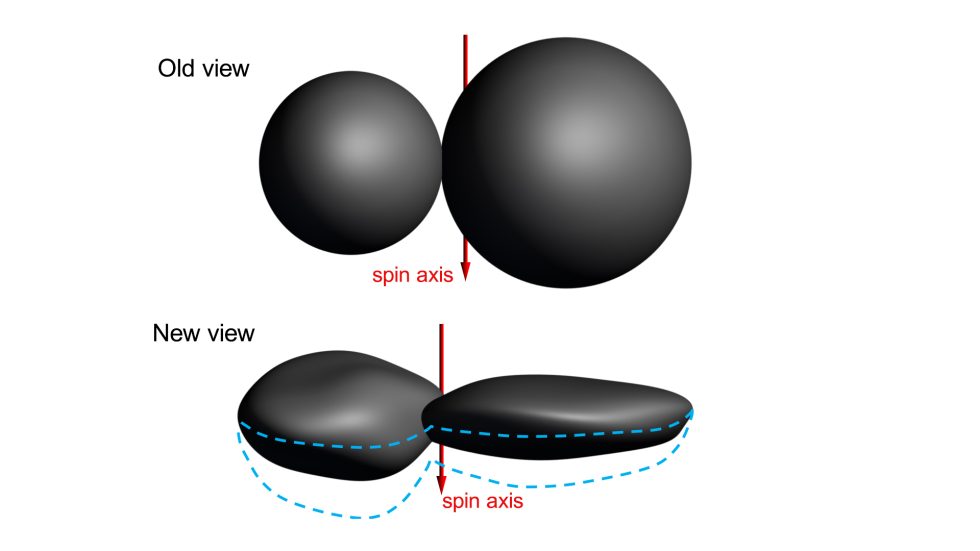|
|
Post by MartinT on Jan 2, 2019 13:08:46 GMT
The photos have been taken and are being sent back now - at a data rate of 1kbps and 6 hours to reach us. It's expected to take until September 2020 to return all the images! New Horizons uses just 190W to remain operational. Phenomenal.
|
|
|
|
Post by jandl100 on Jan 2, 2019 19:50:36 GMT
It's 2 asteroids stuck together!  Much better images will be available soon. |
|
|
|
Post by jandl100 on Jan 2, 2019 19:52:55 GMT
NASA is calling it the Snowman.   |
|
|
|
Post by jandl100 on Jan 2, 2019 20:10:56 GMT
"Astronomy Magazine Great New Findings at Ultima Thule. Among the highlights: it is unquestionably a contact binary with a rotation rate of roughly 15 hours. It appears red and mottled, with a reflectivity ranging from 13% to 6%. There are no obvious impact craters, though the lighting on these early images is not great for detecting them. And there are hints of hills and ridges. We'll be back with more later today."  |
|
|
|
Post by ChrisB on Jan 3, 2019 18:06:38 GMT
Now that the Chinese have landed on the B-side of the Moon, I'm eagerly awaiting the chance to see the first photos of the Soup Dragon. Well, it must be there - the Americans couldn't find it on the A-side.
|
|
|
|
Post by Chris on Jan 5, 2019 18:27:28 GMT
Yet again,amazing times in astronomy.
|
|
|
|
Post by Chris on Jan 5, 2019 18:30:31 GMT
The photos have been taken and are being sent back now - at a data rate of 1kbps and 6 hours to reach us. It's expected to take until September 2020 to return all the images! New Horizons uses just 190W to remain operational. Phenomenal. That's unbelievable. How is it powered and how come it's such low numbers? |
|
|
|
Post by MartinT on Jan 5, 2019 19:16:56 GMT
It has a plutonium reactor to give it very long life, but the power output is still very small. Low data rate? Think of the distance involved. If your broadband gets slower the further away you are from the cabinet, then 1kbps begins to get understandable when you're beyond Pluto!
|
|
|
|
Post by Chris on Jan 6, 2019 15:34:21 GMT
Thank you Martin. Wasn't just thinking data rates though - how come the whole machine uses such low power?
|
|
|
|
Post by jandl100 on Jan 6, 2019 16:10:17 GMT
I think it's simply what you get from a nuclear powered device small enough and light enough and reliable enough and sufficiently long lasting to send across the full width of the solar system given the technology at the time.
The whole mission was designed around the constraints of available onboard power.
|
|
|
|
Post by MartinT on Jan 6, 2019 16:10:46 GMT
How much plutonium do you want taking off in a big rocket?
|
|
|
|
Post by jandl100 on Jan 25, 2019 18:27:24 GMT
The latest, higher rez image of that distant conjoined asteroid pair.  |
|
|
|
Post by Chris on Jan 26, 2019 8:24:37 GMT
How much plutonium do you want taking off in a big rocket? No, o don't get me wrong here,I understand that. i just thought there would be a LOT of power draining devices and such onboard. What I'm trying to get at is how is uses such little power. I find that amazing! |
|
|
|
Post by MartinT on Jan 26, 2019 18:58:38 GMT
Indeed, probably the most power-hungry application is the radio sending the data back.
|
|
|
|
Post by Firebottle on Jan 26, 2019 19:33:52 GMT
I think I read somewhere that some of these probes use something like a 6W transmitter.
The antennas are quite high gain fortunately.
|
|
|
|
Post by MartinT on Jan 26, 2019 19:40:14 GMT
No wonder the data rate is low.
|
|
|
|
Post by jandl100 on Feb 8, 2019 21:45:27 GMT
'Back in early January, when scientists pulled down their first batch of data from the New Horizons spacecraft, they celebrated an odd snowman-shaped object in the outer Solar System. From this first look, it appeared as though Ultima Thule, formally named 2014 MU69, consisted of two spheres in contact with one another—a contact binary. Now that scientists have downloaded more data from the distant spacecraft, however, our view of Ultima Thule has changed. A sequence of images captured as New Horizons moved away from the object in the Kuiper Belt at a velocity of 50,000 km/hour, taken about 10 minutes after closest approach, show a much flatter appearance. The new photos reveal a dramatically different object because they were taken from a different angle than the images that were downloaded first.' The dashed blue lines span the uncertainty, which shows that Ultima Thule could be either flatter than, or not as flat as, depicted in this figure.  arstechnica.com/science/2019/02/it-looks-like-ultima-thule-may-be-more-of-a-pancake-than-snowman/pluto.jhuapl.edu/News-Center/News-Article.php?page=20190208 arstechnica.com/science/2019/02/it-looks-like-ultima-thule-may-be-more-of-a-pancake-than-snowman/pluto.jhuapl.edu/News-Center/News-Article.php?page=20190208 |
|
|
|
Post by jandl100 on Feb 10, 2019 15:53:42 GMT
|
|
|
|
Post by jandl100 on Feb 24, 2019 8:41:23 GMT
More from the Kuiper Belt, a billion miles beyond Pluto . Best image yet ...  Resolution is 33 metres per pixel. "Bullseye!" said New Horizons Principal Investigator Alan Stern, of the Southwest Research Institute (SwRI). "Getting these images required us to know precisely where both tiny Ultima and New Horizons were—moment by moment – as they passed one another at over 32,000 miles per hour in the dim light of the Kuiper Belt, a billion miles beyond Pluto. This was a much tougher observation than anything we had attempted in our 2015 Pluto flyby. "These 'stretch goal' observations were risky, because there was a real chance we'd only get part or even none of Ultima in the camera's narrow field of view," he continued. "But the science, operations and navigation teams nailed it, and the result is a field day for our science team! Some of the details we now see on Ultima Thule's surface are unlike any object ever explored before." |
|
|
|
Post by MartinT on Feb 24, 2019 10:08:12 GMT
Amazing!
|
|